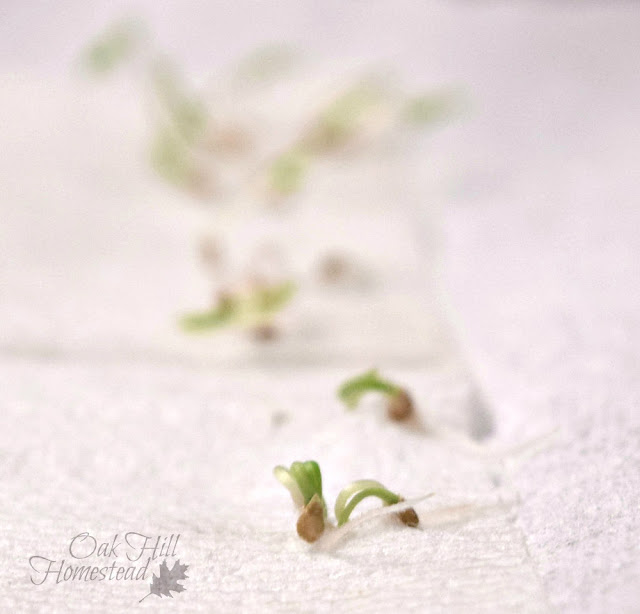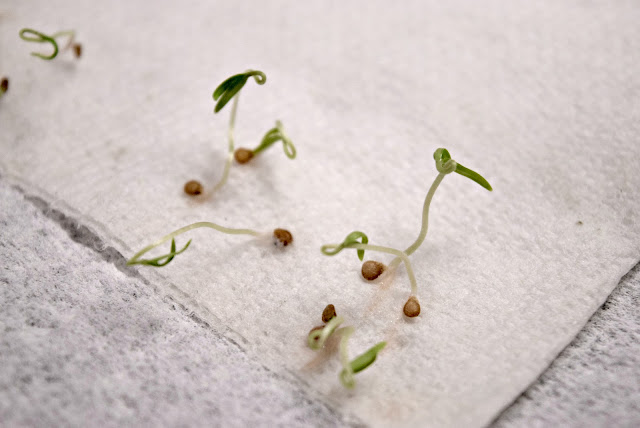If you have leftover seed packets from previous years or if you've saved seeds from your own garden, this guide on how to test seeds for germination is your key to success.
These seed viability test tips will help you plant with confidence.
How to test seed germination rate
My husband says I hoard garden seeds like I hoard canning jars. He realized just how many jars I have when we moved a few years ago.
He also realized how many seed packets I have when I sorted through them at the kitchen table the other day in anticipation of spring planting.
I have a lot of seed packets. And I ordered more over the winter to plant this spring. I just can't say no.
Seeds don't last forever. They are living things, and living things eventually die. You can store leftover seeds from one season to plant the next season if you store them correctly, as long as you realize that eventually they have to be replaced.
The best way to save seeds is to plant half of them one year, and then save the seeds those plants produce. The next year, you’d plant the other half of the seeds.
That way, if one year's crop fails for some reason, you’d still have the seeds you saved the year before.
This is how to keep viable seeds from year to year if you have some rare seeds, or some that are particularly important to you.
Perhaps your family has grown a particular variety of green beans for several generations, and the seeds have become perfectly acclimated to your climate and growing conditions.
But not all of us have the ability or the space to do this every year.
Viability and germination rates
Seeds are the dormant state of plants.
Germination is the word used when a seed begins to sprout and grow, when it “comes back to life” from its dormant state.
Viable seeds are seeds that are alive and able to grow and produce plants when the conditions are favorable. Seed viability is the rate at which the seeds germinate, or sprout.
As time passes, seeds lose their ability to germinate.
The percentage of viable seeds in a seed packet is known as the germination rate. If you planted ten seeds and only eight germinated or sprouted, the germination rate of that seed packet would be 80%.
Testing the germination rate of your seeds is important so you’ll know if your seeds are worth planting, or if they should be replaced with fresh seeds.
How long do seeds last?
Different types of seeds have different lifespans or storage times. However, the estimated number of years is just that: an estimation, an average. If you’ve stored your seeds well, they can last longer than what the experts say.
Corn, okra and onion seeds are relatively short-lived, while other types of seeds can last for 5 years or more. [Source]
Of course, seeds need to be stored correctly in order to remain viable for as long as possible.
How do you know if your stored seeds are still good?
The main reason to check seed for viability is because you’ve stored the seeds for several years.
Seed that has been improperly stored may have a low germination rate or none at all.
If you save seed from your garden, some of the seeds may be immature or improperly gathered.
But you can’t tell if seeds are viable just by looking at them. In these cases, it's important to do a seed germination test.
How to test the viability of garden seeds
There are several ways to test seeds for germination rate. Here are two ways to tell if your seeds are good or bad.
Disclaimer: the seeds of some plants require scarification (weakening or removing the seed coat) in order to germinate. Other seeds require stratification (a certain amount of chilling time) before they will germinate. The tests below will not work for those seeds unless you have followed the recommendations for stratification and/or scarification for those specific seeds.
Here are two ways to do a quick germination test at home.
The water germination test
This test, used to test large seeds such as peas, beans and corn, involves dropping the seeds in a glass of water. Leave them for about 15 minutes, then come back and check them.
The seeds that have sunk to the bottom of the glass are good, viable seeds. The ones that remain floating on top of the water are not viable and should be discarded.
The paper towel germination test
Sometimes called the baggie test, this is a simple way to test your seeds for viability. Although it isn’t as fast as the water test, it is still easy to do.
To perform a seed germination test, you’ll need:
- A paper towel
- A plastic bag with a zipper closure
- Seeds to test
Place a moist (not dripping wet) paper towel inside the plastic bag. Place 10 seeds on the paper towel.
Then fold the towel over the seeds to keep them evenly moist.
Leave the bag undisturbed at room temperature (or a warm place if your home is cold). Most types of seeds will germinate in either dark or light conditions. More important than light at this stage is warmth and moisture.
Don’t put the baggie in direct sunlight.
Check daily to make sure the towel hasn’t dried out. If the paper towel seems too dry, you can spritz it with water from a spray bottle.
How long does it take seeds to germinate?
Your seed packet should state how many days it takes for the seeds to germinate. This is an average number, of course, based on perfect conditions.
Your seeds might take several days longer, or they may sprout a bit earlier, depending on conditions.
If you don’t know how many days it will take for the seeds to germinate (if you saved the seeds from your garden, for instance, and you don’t have a seed packet for reference), wait 7-10 days to check the seeds.
Often seeds don’t all germinate on the same day, so if only 1 or 2 sprout the first day, don't be discouraged.
Once they begin to germinate, check on them daily. Write down how many seeds have sprouted. When two days or more go by without any new sprouts, you can assume the rest of the seeds aren’t viable.
If mold develops on your seeds, throw them all away and start over with a new paper towel and plastic bag. Make sure the paper towel isn’t too wet.
Be sure to give your seeds enough time to germinate before you give up. If you are testing rare seeds that are hard to replace, you can wait as long as 4-6 weeks as long as no mold develops.
What the seed germination test will tell you
If you used ten seeds in the germination test, and eight of them germinated or sprouted, your germination rate is 80%. If only three germinated, they have a 30% germination rate.
If the germination rate is low, you can hedge your bets by sowing a larger number of seeds in your garden to get the number of plants you need.
At a 50% germination rate, you will need to plant 20 seeds in the garden to get approximately 10 plants.
A very low germination percentage is a sign that you should replace your seed with fresh seed.
If you saved the seeds from your own garden, they may not all have been completely ripe, or were improperly stored.
After the seed germination test
If you are dealing with rare seeds, or seeds that are from your absolute favorite variety that is hard to find, and your seeds did not germinate, you can try germinating a second batch of seeds.
Any seeds that do germinate can be planted in containers or in the garden as usual.
In fact, while many people discard the seeds that germinate during this test, the seeds can be planted if the timing is right.
While you can’t plant tomatoes in January in most parts of the world, if the season and the weather are right, go ahead and plant them. I think they deserve a chance at life!
Successful gardening begins with the vitality of your seeds. Now that you know how to test your seeds' germination rates, you are on the way to a productive, thriving vegetable garden.
For more gardening and self-sufficient posts like this, subscribe to my weekly-ish newsletter The Acorn, and join me on Facebook, Instagram and Pinterest. I'd love to see you there!
Related posts:
Beginner's Guide to Starting Seeds Indoors
How to Store Leftover Seeds for the Best Germination Rate Next Year
~~~~~
My mission is to inspire and encourage you to live a simple, joyful life,
no matter your circumstances or where you live. Join me here:
Facebook | Pinterest | Instagram | Subscribe
updated on 3/3/2024


















